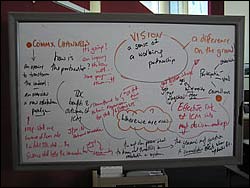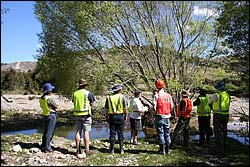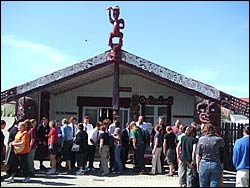Integration and modelling
 |
Integration? |
Introduction
One of the key elements of the ICM programme concerns "integration". While this word means many different things to different people it is really about the way in which research is done as well as how it is used.
Researchable Issues
- Social integration
- Institutional behaviour
- IDEAS modelling framework
- Modelling
- Catchment futures
- Knowledge delivery
Research Areas
-
Ecosystem models of Tasman & Golden Bays
The ultimate aim of environmental studies is to develop the ability to predict ecosystem responses to particular events. This can be achieved through the use of predictive models. -
Fine sediment: bringing the geomorphology and biology together
Suspended sediment effects on freshwater and coastal habitats. -
Futures modelling
-
IDEAS
The purpose of IDEAS is to provide an Integrated Dynamic Environmental Assessment System within which modelling tools provide answers to real catchment questions about cumulative causes and effects of a mosaic of catchment developments. IDEAS is a strategic planning tool for testing “futures scenarios” involving a triple bottom–line approach, a collaborative learning development process, and assessment of cumulative effects in land and water management. -
Knowledge delivery
The knowledge delivery strategy for the ICM Motueka research programme uses innovative approaches to deliver its results to its stakeholders and research partners including this web site, CD–Rom, reports, publications, etc. -
Knowledge interactions
-
Modelling water quantity and quality
-
River plume ecosystem
Are there definable ecosystem characteristics that are significantly affected by the freshwater discharge from the Motueka River? -
Sediment generation, delivery and impacts
Sediment may have a range of impacts on the ecology and habitat of both freshwater and marine ecosystems. To understand and manage these impacts it is important to determine the major sources of sediment generation as well as establish changes in riverbed characteristics important to maintenance of the trout fishery, and delivery of sediment to the marine environment. -
Sediment learning group
-
Stakeholder issues
Key stakeholders with interests in the Motueka River catchment were surveyed in January–February 2000, to prioritise research issues relevant to natural resources management in the catchment.
The project was commissioned by the Tasman District Council, as an integral part of activities associated with the development of a research programme funded by the Foundation for Research, Science, & Technology, entitled "Integrated management of land and water resources in complex catchments" – eventually to become known as the Motueka ICM programme. -
Tall vegetation effects on water yield
A decision support system has been developed to assist land managers in assessing possible changes in water yield from a catchment with a change in vegetation cover.
 |
 |
Sediment learning group |
Welcome at Te Awhina marae |
Publications (Selection)
Presentations (Selection)
Primary Contacts:

|
Will Allen
Email Phone: 03 321 9600 More details» |
Institute Landcare Research |
Expertise participation, multi–stakeholder processes, participatory evaluation, networking |

|
Tim Davie
Email Phone: 03 372 7084 Fax: +64 (0)3 365 3194 More details» |
Institute Environment Canterbury |
Expertise Hydrology & modelling, surface water resource management |

|
John Dymond
Email Phone: 06 353 4955 |
Institute Landcare Research |
Expertise land and water models, GIS, remote sensing |

|
Chris Phillips
Email Phone: +64 3 321 9775 More details» |
Institute Landcare Research |
Expertise Erosion processes, slope stability, effects of forestry, catchment management, knowledge management |
Page last updated Wednesday, 20 June 2007